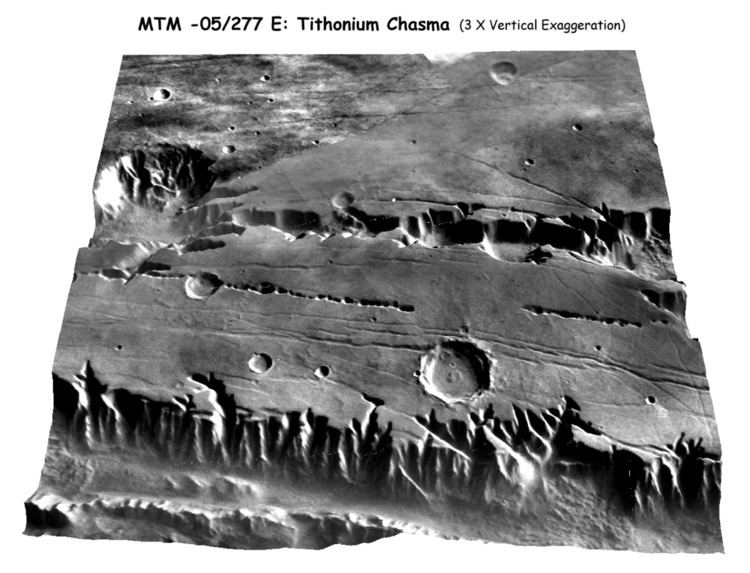 | ||
A digital elevation model (DEM) is a digital model or 3D representation of a terrain's surface — commonly for a planet (including Earth), moon, or asteroid — created from terrain elevation data.
Contents
Terminology
There is no universal usage of the terms digital elevation model (DEM), digital terrain model (DTM) and digital surface model (DSM) in scientific literature. In most cases the term digital surface model represents the earth's surface and includes all objects on it. In contrast to a DSM, the digital terrain model (DTM) represents the bare ground surface without any objects like plants and buildings (see the figure on the right).
DEM is often used as a generic term for DSMs and DTMs, only representing height information without any further definition about the surface. Other definitions equalise the terms DEM and DTM, or define the DEM as a subset of the DTM, which also represents other morphological elements. There are also definitions which equalise the terms DEM and DSM. On the Web definitions can be found which define DEM as a regularly spaced GRID and a DTM as a three-dimensional model (TIN). Most of the data providers (USGS, ERSDAC, CGIAR, Spot Image) use the term DEM as a generic term for DSMs and DTMs. All datasets which are captured with satellites, airplanes or other flying platforms are originally DSMs (like SRTM or the ASTER GDEM). It is possible to compute a DTM from high resolution DSM datasets with complex algorithms (Li et al., 2005). In the following the term DEM is used as a generic term for DSMs and DTMs.
Types of DEM
A DEM can be represented as a raster (a grid of squares, also known as a heightmap when representing elevation) or as a vector-based triangular irregular network (TIN). The TIN DEM dataset is also referred to as a primary (measured) DEM, whereas the Raster DEM is referred to as a secondary (computed) DEM. The DEM could be acquired through techniques such as photogrammetry, lidar, IfSAR, land surveying, etc. (Li et al. 2005). DEMs are commonly built using data collected using remote sensing techniques, but they may also be built from land surveying. DEMs are used often in geographic information systems, and are the most common basis for digitally produced relief maps. While a DSM may be useful for landscape modeling, city modeling and visualization applications, a DTM is often required for flood or drainage modeling, land-use studies, geological applications, and other applications.
Production
Mappers may prepare digital elevation models in a number of ways, but they frequently use remote sensing rather than direct survey data. One powerful technique for generating digital elevation models is interferometric synthetic aperture radar where two passes of a radar satellite (such as RADARSAT-1 or TerraSAR-X or Cosmo SkyMed), or a single pass if the satellite is equipped with two antennas (like the SRTM instrumentation), collect sufficient data to generate a digital elevation map tens of kilometers on a side with a resolution of around ten meters. Other kinds of stereoscopic pairs can be employed using the digital image correlation method, where two optical images are acquired with different angles taken from the same pass of an airplane or an Earth Observation Satellite (such as the HRS instrument of SPOT5 or the VNIR band of ASTER).
The SPOT 1 satellite (1986) provided the first usable elevation data for a sizeable portion of the planet's landmass, using two-pass stereoscopic correlation. Later, further data were provided by the European Remote-Sensing Satellite (ERS, 1991) using the same method, the Shuttle Radar Topography Mission (SRTM, 2000) using single-pass SAR and the Advanced Spaceborne Thermal Emission and Reflection Radiometer (ASTER, 2000) instrumentation on the Terra satellite using double-pass stereo pairs.
The HRS instrument on SPOT 5 has acquired over 100 million square kilometers of stereo pairs.
Older methods of generating DEMs often involve interpolating digital contour maps that may have been produced by direct survey of the land surface. This method is still used in mountain areas, where interferometry is not always satisfactory. Note that contour line data or any other sampled elevation datasets (by GPS or ground survey) are not DEMs, but may be considered digital terrain models. A DEM implies that elevation is available continuously at each location in the study area.
The quality of a DEM is a measure of how accurate elevation is at each pixel (absolute accuracy) and how accurately is the morphology presented (relative accuracy). Several factors play an important role for quality of DEM-derived products:
Methods for obtaining elevation data used to create DEMs
Uses
Common uses of DEMs include:
